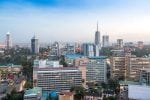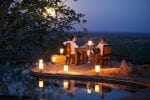Meru National Park is one of the most beautiful parks in Africa. And besides being home to lions, cheetahs, leopards, elephants and rhinos, it is also known for its diversity of habitats and wildlife including the rare kudu. Your guide knows all the amazing corners of the park, from the palm-fringed waterholes to the sandy beaches of the Tana River. A paradise for birdwatchers. Meru contain over 450 species, surprising botanical treasures as well as the giant baobab tree, also known as “Tree of life”.

Ecorating: 4.0
This product meets our requirements for Ecorating, a product that is good for humans and the environment.
Does my trip make a difference?
Read more
This product meets our requirements for Ecorating, a product that is good for humans and the environment.
Sample Itinerary

When you have arrived at Nairobi airport you will be met by a representative who will take you to a hotel for rest and overnight stay including breakfast.

After an early breakfast in your hotel you will meet with your guide who will accompany you throughout your safari. Start your journey in a 4×4 jeep through different landscapes. Climb up to 2750m and then down to 900m with dramatic views of the Great Rift Valley.
You will have lunch at Barney’s Restaurant in Nanyuki. After lunch, continue onto Meru and arrive at Elsa Kopje late afternoon. Your stay at Elsa Kopje will offer activities like guided bush walks, bush meals, local school visits and community projects. Fishing in the Tana or Rojewero rivers, enjoy a massage, a sundowner or just relaxing by the pool.

Elsa’s Kopje has several accommodation options to choose from; a private house, honeymoon suites and a family suite.

Enjoy guided bushwalks in wonderful nature…

…and maybe a private dinner by the pool in the evening.
Trip details
Eco rating: 4.5
Hotel standard: 5
Season: June – April
Airport: Nairobi international airport Jomo Kenyatta (NBO)
Length: 4 nights or as long as you wish.
Included: Full board, share in double, safari, walking safari, conservancy entrance fee, domestic flight return Nairobi- Masai Mara.
Not included: Travel Insurance, Visa, immunization, beverages, activities, items of personal nature etc.
Good to know about Kenya & Meru: Meru National Park is located east of Meru, 350 km from Nairobi. The area covers 870 km², and is one of Kenya’s most famous national parks. Rain is plentiful and the rain results in tall grass and lush trees. The park has a wide variety of wildlife including the african bush elephant, the eastern lion, african leopard, kenyan cheetah, black rhino and white rhino, grévy zebra and hippos.
Travel Ethics: Masais are proud people, always ask before photographing. Bring small notes in local currency to shop for local crafts outside the villages. Shake hands with those you meet – a courtesy code here.
Mobile network and email: Email and internet access are available at the lodge. The mobile network works well. Management ask guests to use it discreetly.
Visa: Visitors to Kenya require a visa (some countries that are exempt). The passport must have at least two blank pages, six months’ validity. Single-entry visas are available upon arrival at Kenyan airports; however, Kenyan Immigration plans to end visas upon arrival in the near future. The traveler is responsible for the visa application.
You can either obtain a visa before departure or apply for a Kenyan visa online.
Currently, the application online is for “Single entry”. Visitors are requested to register their application in good time, as approval may take up to seven business days to process.
E-application: Applications for visitors to Kenya can be done via www.ecitizen.go.ke
Time zone: GMT + 3
Vaccinations: Read more about what vaccinations you need here.
Packing: On safari nights and evenings can be a bit more chilly. Bring a warmer sweater and good walking shoes. It’s advisable to bring a smaller backpack with room for water, binoculars and camera. Soft bags are easier to pack in the cars you travel in, please note that domestic flights only has luggage allowance of a max weight of 15kg pp.
Mosquito nets are available, but please bring mosquito spray.
Local Currency: Kenyan Shilling
Note: Kenya has recently introduced a ban on plastic bags and your bags will be checked as you enter customs upon arrival in Kenya. Carrying plastic bags or bringing them into the country can cause large fines.
Weather: Weather Meru National Park
Water: Clean water is available at the camp.
Security: Your security is our priority. In Nairobi, do not walk around alone and avoid some places in Down Town.
More information at: Travel Advice Kenya

Ecorating: 4.0
This product meets our requirements for Ecorating, a product that is good for humans and the environment.
Does my trip make a difference?
Read more
This product meets our requirements for Ecorating, a product that is good for humans and the environment.
Conservation
An enormously popular safari place through the 60’s and 70’s, a 80-th 90-poaching crises that saw a lot of Meru elephants slaughtered and rhinos that were completely extinct from the area. The park’s infrastructure was broken down when tourism dropped and rumours circulated that the government was about to close the park.
Despite the state of the park, with a passion for its beautiful wilderness, Stefano & Liz Cheli believed that they could build a successful lodge to secure Merus’ future existence. They started a discussion with KWS in 1993 and after four years of negotiations they received the approval. Since the lodge was built in 1999, Meru National Park has experienced a steady increase in tourists from a number of 3 500 in 1999 to 15 200 in 2009. It now has a reputation as one of the best wilderness areas in the safari circuit. Elsa Kopje contributes to Kenya Wildlife Service (KWS) through leasing fees and park fees.
The generation of these funds has triggered KWS recovery measures, infrastructure and security networks have been introduced. At least 1,350 animals have been successfully translocated to Meru, including reticulated giraffes, Grevy zebra, impala, leopard and elephant. The rich diversity of wildlife contains over 450 species of birds.
KWS has also opened another 20,750 acres in 2003, which now protects a population of over 70 white and black rhinos. Elsa Kopje has undoubtedly made Meru National Park once again a viable conservation area.
Sustainable tourism
As a recognition of high environmental responsibility, Elsa Kopje has been awarded “Gold Level” by the Kenyan Ecotourism Society, and in 2016, “Silver Level” was achieved with an international certification with Sustainable Tourism International.
The lodge consumes a minimal amount of energy through investments in LED and energy-saving lamps. They use solar power to supplement the generator, which limits the diesel generator’s use for only 6 hours a day. In order to limit carbon dioxide emissions and support the local community, fresh produce from local farmers is purchased and local traders and timber used by the camp is taken from renewable sources. Rubbish is handled responsibly or recycled and separate glass is sold to the Central Glass recycling plant in Nairobi.
[cl-ib image = “1649” title = “Ecorating: 4.0 of 5.0” desc = “This product meets our requirements for Ecorating, a product that is good for humans and the environment” animation = “aidos”]




